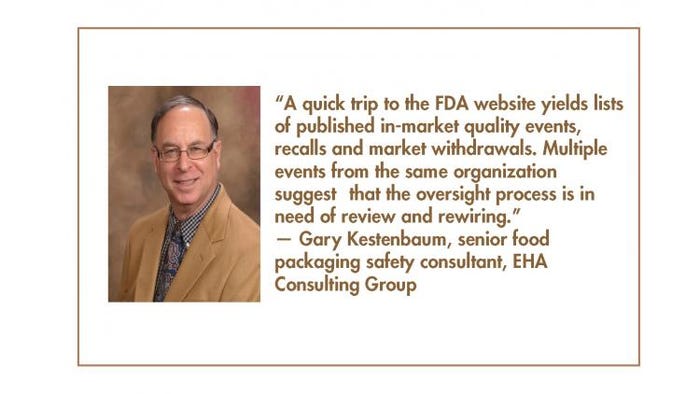Food packaging safety: Avoiding '911' emergencies Part 1
July 26, 2017

What do you do when changing conditions transform limited food packaging risks into absolute certainties? Food safety expert Gary Kestenbaum knows.
Packaging Safety Expert Gary Kestenbaum offers guidance for evaluating, anticipating and recognizing business conditions that impact food packaging component safety and suitability risks before they advance from infrequent and manageable into recurring and calamitous.
Established food and food packaging facilities typically enjoy a consistent and reliably safe supply chain. Oversight and control is based on predictability with limited changes be they known, anticipated or unexpected.
However, with historic upgrades in regulatory oversight and the need for sustaining profitability, changes occur at a dizzying pace, and any changes in a chain affect all downstream players. Quality, consistency, reliability and safety can become predictably unpredictable. “Sure thing” quality characteristics of products or processes reside as future liabilities because they are considered invisible, on” auto pilot” based on long-term favorable reliabilities.
Typically, packaging “army of one” quality managers focused oversight on expected high-risks and demonstrated “bad actors.” Occasionally, low-risk or low-frequency defects occurred and were addressed at that time. Even when a supply chain change occurred, it was handled, per se. Defect levels increased temporarily and were “managed.” Over time, though, sporadic defects became more consistent and annoying. When defects result in a food safety or unsuitability issue, the stakes increase significantly, and will not be tolerated by customers and regulators.
Job one is to assess and quantify true risks and the actual or potential harm to people and profits from those risks. That process needs oversight and ownership by cross-functional teams who should be taught to function as ad-hoc insurance actuaries. Job two is to have solutions in hand, ready to implement in advance of risks becoming events.

A quick trip to the FDA website yields lists of published in-market quality events, recalls and market withdrawals. Multiple events from the same organization suggest that the oversight process is in need of review and rewiring.
The important learning from increases to in-market product unsuitability events suggests changing conditions: changes in supplier, materials, process, resources or other modification. Manufacturers are not blind to addressing product quality, safety and suitability, but usually limit themselves to the existing internal written and practiced process and in doing so they may fail to properly consider how changing circumstances or conditions increase risk potential. In light of the enhanced authority given FDA from FSMA and related food safety rules, federal regulators have stated that they are expecting U.S. food supply chain suppliers, including the food packaging industry, to continuously review, evaluate and adjust assumptions, programs and controls, in advance, to prevent or reduce risk of in-market calamities.
Consider the analogy from a recent New York Times article that mentioned domestic flood and fire risks. Changing conditions facilitated irreversible increases for risks from floods, fires and related catastrophic property damage. The article stated that as time marched on, data showed that it wasn’t a question of whether there’d be floods or fires in targeted areas, only how often and how broad the scope. The key takeaway was that changing conditions in weather patterns, topography and environment were guaranteeing that calamities characterized as risks in the 1980s had evolved into certainties in 2017. Insurers will provide coverage for possibilities, but they recoil from covering certainties. How many times will an insurer fund a total rebuild or other expensive disaster before it simply withdraws coverage?
The classic argument within industry that “it never happened to us in all our years in business” is tantamount to the quote in the New York Times article that “although [the scope and impacts of super-storms] Katrina and Sandy felt like once-in-a-lifetime events, there is actually a 50% chance within a 10-year period” that there will be other Hurricane Sandy-sized losses. The article went on to define the term “100-year flood.” The public takes that to mean “one catastrophic flood every 100 years.” That is not what a 100-year flood means.
The article observed that there was a narrow window of opportunity for affected property owners living in high flood risk areas to accept a one-time mitigation offer, or assume 100% of the risk going forward. If would be fair to assume that food packaging manufacturers face the same terms in the event that insurance loss potentials become loss certainties.
Identify costly and harmful food safety or suitability risks to your products.
• Are you aware of potential causes and extents?
• Are effective root-cause analysis and corrective action control mechanisms in place?
• If one slips through and harm occurs, do you have insurance to protect your business from such a calamity?
• How will you react if a loss event reoccurs?
• Who will insure you once it is public knowledge that you have an unmitigated risk generator in your process?
Not having answers and solutions to these questions leaves your company at high risk for financial and reputational losses.
When (formerly) sporadic-turned frequent calamities occur in the food supply industry as a whole, they are sure to pop up on insurer’s actuarial “hit lists” of known risks. The food industry likely resides within insurers’ “yellow flag” categories already due to the impact on human injury and the high costs of market withdrawals and recalls. When given a reason to recalculate, insurers will quickly re-calculate and make the necessary adjustments including inspections, enhanced questionnaires, higher premiums and deductibles and, at worst, cancellation and rejections. For those companies who self-insure, the risk of increased in-market calamities can quickly affect the entire business model.
The conundrum exists that even though every food supply situation is unique, there are of course commonalities shared by every category in the industry. A good example is off-shore sourcing of materials, be they raw, intermediate or finished. Sourcing off-shore does not in its own right assure high risk; certainly, there have been many market withdrawals and recalls facilitated by errors and omissions within the continental United States, but it would be fair to say that sourcing from outside North America adds risks, challenges and degrees of difficulty including, but not limited to U.S. Government oversight, political climates, cultural differences, the inconvenience of distance, language and communication, resource limitations and other fixed elements which are difficult to foresee or control.
A case study in futility
I was once in India to oversee packaging of bulk food products. After reviewing one supplier’s process for case-packing bulk nuts and loading said cases into a shipping container, it was obvious that their loading pattern needed improvement. I carefully measured the case dimensions, plugged said values into a software optimization program and voila, a new and efficient pattern was created.
You can imagine how excited I was as we began to load a container the next day using the new pattern. Smiles quickly turned to puzzled expressions when the pattern didn’t work because case dimensions didn’t match the internal limits in the container. “How did I screw that up,” I fumed? A careful dimensional audit of knocked-down shipping cases culled from bundles in the warehouse exposed a wide variation in case dimensions, and I do mean WIDE! Variable and unpredictable enough to make cubic efficiency impossible to control.
When I asked the owner/operator of the facility how likely it was for him to reach out to the corrugated manufacturer and request/receive consistently dimensioned goods, he laughed. Such control was either impossible, unlikely and hard to enforce. Added costs of auditing, oversight, rejection and corresponding impact to his process made such a change impractical. After that “aha” moment, I realized that many of the options in my packaging book of tricks intended to anticipate defects and apply controls were rendered useless.
To prove my point, I commissioned a consistently produced order of optimally dimensioned shippers, manufactured by a corrugated converted in the U.S. The cases were filled with product, as in India, and test-shipped in a similar container. Results were as expected, but, because of conditions beyond my control, the corrective plan was useless.
The next edition of this blog will explore processes that a food packaging organization can integrate to evaluate, control and react to quality/safety risks to its products.
Gary Kestenbaum has 40 years’ experience in the food and packaging industries, six as a supplier with National Starch, 18 as a product developer with General/Kraft Foods and 15 as a packaging engineer and developer with Kraft. As senior food packaging safety consultant with EHA Consulting Group, Kestenbaum provides guidance on packaging safety and suitability-related projects for raw material manufacturers, converters and associated supporting professionals. He can be reached at [email protected] or 410-484-9133. The website is www.ehagroup.com.
___________________________________________________________________________________
MinnPack celebrates its 15th year to bring the latest developments in food, beverage and all things packaging as part of a comprehensive 6-event megashow in Minneapolis November 8-9 that also includes PLASTEC. For more information, visit http://minnpack.packagingdigest.com.
___________________________________________________________________________________
About the Author(s)
You May Also Like




